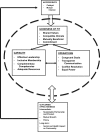Partnership readiness for community-based participatory research
- PMID: 20837654
- PMCID: PMC3396876
- DOI: 10.1093/her/cyq050
Partnership readiness for community-based participatory research
Abstract
The use of a dyadic lens to assess and leverage academic and community partners' readiness to conduct community-based participatory research (CBPR) has not been systematically investigated. With a lack of readiness to conduct CBPR, the partnership and its products are vulnerable. The purpose of this qualitative study was to explore the dimensions and key indicators necessary for academic and community partnership readiness to conduct CBPR. Key informant interviews and focus groups (n = 36 participants) were conducted with academic and community participants who had experiences with CBPR partnerships. A 'framework analysis' approach was used to analyze the data and generate a new model, CBPR Partnership Readiness Model. Antecedents of CBPR partnership readiness are a catalyst and mutual interest. The major dimensions of the CBPR Partnership Readiness Model are (i) goodness of fit, (ii) capacity, and (iii) operations. Preferred outcomes are sustainable partnership and product, mutual growth, policy and social and health impact on the community. CBPR partnership readiness is an iterative and dynamic process, partnership and issue specific, influenced by a range of environmental and contextual factors, amenable to change and essential for sustainability and promotion of health and social change in the community.
References
-
- Israel B, Schulz A, Parker E, et al. Review of community-based research: addressing partnership approaches to improve public health. Annu Rev Public Health. 1998;19:173–202. - PubMed
-
- Minkler M, Wallerstein N. Introduction to community-based participatory research. In: Minkler M, Wallerstein N, editors. Community Based Participatory Research for Health. San Francisco, CA: Jossey-Bass; 2003. pp. 3–23.
-
- Israel B, Schulz A, Parker E. Critical issues in developing and following community-based participatory research principles. In: Minkler M, Wallerstein N, editors. Community-Based Participatory Research for Health. San Francisco, CA: Jossey-Bass; 2003. pp. 53–76.
-
- Andrews JO, Bentley G, Crawford S, et al. Using community-based participatory research to develop a culturally sensitive smoking cessation intervention for African Americans in public housing neighborhoods. Ethn Dis. 2007;17:331–7. - PubMed
-
- Andrews JO, Felton G, Wewers ME, et al. Sister to sister: assisting southern low-income women to quit smoking. Southern Online J Nurs Res. 2005;6:2–23.


